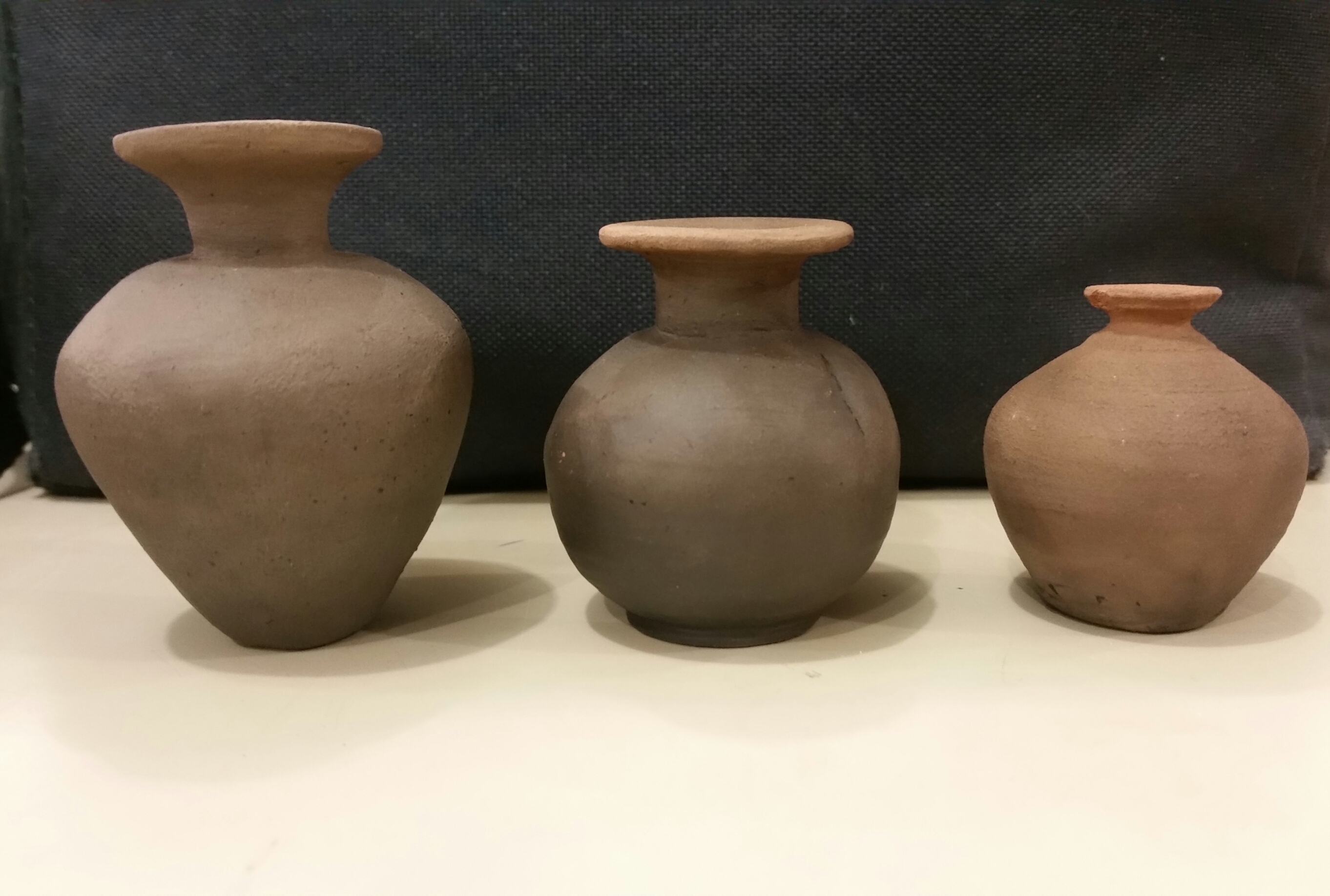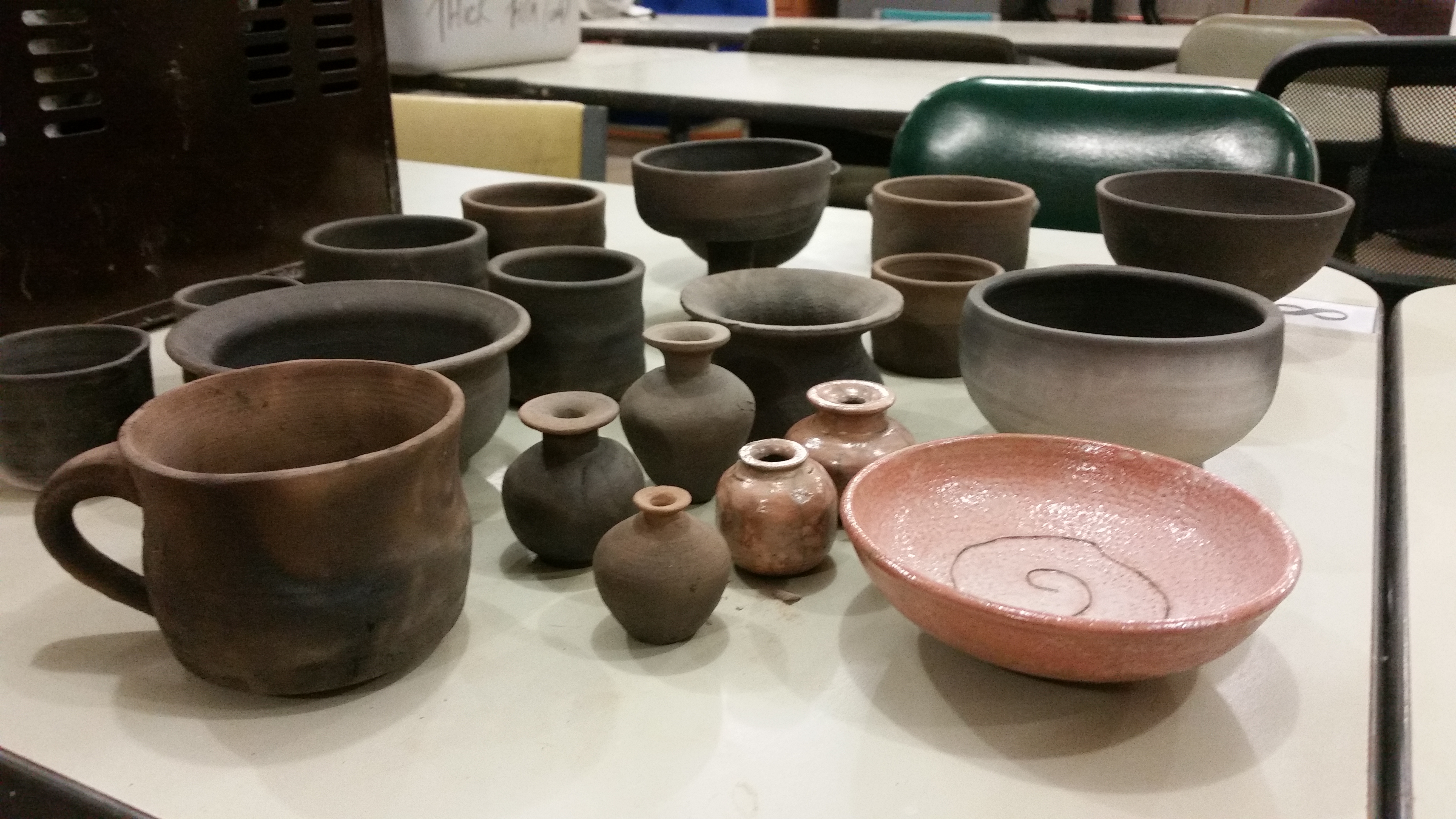Three interns worked with our LTT Resident Ceramics Instructor, Cynthia Jones, for Spring semester 2016, some continuing their work from Fall 2015. Below are the reports of their projects. We are extremely grateful that Cynthia Jones dedicated her time and expertise during the entire academic year 2015-2016 and plans to continue for AY 2016-2017.
LUKE KAISER (Anthropology, Doctoral Candidate)This semester was my most active semester in the LTT thus far, and I hope I can duplicate my Spring 2016 progress in Fall 2016. In summary, I burnished 19 wheelmade cups, bisqued them in the LTT kilns, and fired them at Cynthia Jones’s studio using two different techniques. Additionally, I learned how to use slab technique for making handmade vessels, and I also became familiar with glazing.
In order to further elaborate on my Spring 2016 projects in the LTT, I will first discuss the wheelmade, conical cups which are similar in shape and appearance to those seen in the Neopalatial/Late Minoan period in Crete. Due to a rapidly approaching firing date, I chose not to make any of these cups by hand, preferring to utilize Cynthia’s skill on the wheel in order to produce these cups both quickly and uniformly. The goal of this project was not to reproduce conical cups with complete accuracy but instead to test firing techniques with the hope of reproducing the mottled look of Vasiliki ware ceramics. With Cynthia’s guidance, I split my 19 cups between two techniques: raku and pit firing which was actually done in an aluminum trash can. The raku technique, originating in East Asia, required the cups to be fired in a kiln then placed into a trash can in order to be reduced. In contrast, the trash can pit firing technique required each vessel to be wrapped in newspaper, quickly dipped in water, buried in alternating layers of paper and wood shavings within the trash can, and allowed to burn overnight. The raku technique did create a mottled look, but the overnight pit fire, though not utilizing the exact conditions or fuels that the Minoans would have, produced a finish that one could say was at the very least reminiscent of the appearance of Vasiliki ware. I hope to improve the conditions of the pit fire in order to make a more authentic reproduction in Fall 2016, but, overall, I am quite pleased with the outcome.
My second project gave me an opportunity to work on the third and final handbuilding technique that I was interested in learning. In Fall 2015, I learned pinch and coiling techniques, but I did not get a chance to do slab technique. I came across some Italian, slab-built vessels in a home décor store in Greensboro, North Carolina while shopping with my parents, and I decided to replicate them. I showed the images to Cynthia, and she assisted me in planning my build. I purchased my own clay and glaze, and from it I made a tall Collins-esque mug, two rocks glasses, a coffee mug, and two bowls. Other than the handle on the coffee mug, each vessel consisted of no more than two separate pieces of clay. I glazed them and fired them in the kilns in the LTT, and was quite happy with my results. At this point, I feel confident enough in my handbuilding techniques in order to return to some of the more traditionally Minoan shapes and decorations that I originally intended to reproduce.
|
|
KELLY MOSS (MA candidate, Classics Department):
Over the semester I have continued to learn how to make pottery (including processing raw clay and throwing on a wheel) and to explore Ancient Greek vessel shapes.
After going in twice a week on average to the lab, I have learned how to process clay completely from start to end. This included going out to harvest clay from the desert. After processing the collected clay with vinegar, we then sifted the clay through a fine sieve so that only the finest clay particles were available. Once the clay had dried out some, we were able to wedge this clay to remove air pockets and make the clay particles more similar. This then allowed us to throw on the wheel with this clay body in order to create some pieces to fire. We also learned how to fire these pieces. This process involved a bisque fire in a kiln, which was followed by a normal firing. This firing took place outdoors, and we used a reducing environment in order to create flash patterns that occasionally highlighted the inclusions of copper in the raw clay deposit.
Over the last year, I have spent a lot of time learning to throw pottery on a wheel. I am now a proficient potter and have begun to experiment with different shapes. I created a series of different types of feet, attempted quick production work, worked on consistency, and learned to make various shapes. This is helping me to be able to read pottery in my volunteer work in the pottery vault at the Arizona State Museum. I anticipate that this will also be a useful skill over the summer in the field. I am hoping it will accelerate my ability to read and process ceramics from future excavations I will be working on.
During the course of my time learning how to create pottery, I realized that I am better at making small pieces and even miniatures. I decided to take on a project to create replicas of the progression of aryballoi from the Protocorinthian period. These shapes are small and were made quickly due to the high demand for this shape. I am still trying to master the techniques involved in this process. After this I intend to create accurate replicas from actual recorded pieces. At the very least, this will result in a collection of aryballoi replicas in chronological order. At best, this could result in the opportunity to record the experimental process of creating and even using these vessels and what this might have meant in antiquity.
JEREMY TURNER (MA Classics Department):
During the Spring 2016 semester at the University of Arizona in association with the Laboratory for Traditional Technology I was provided the opportunity to work with a local Tucson potter, Cynthia Jones, to learn more about ceramic production sequences. My archaeological research focuses on ceramic production as well as distribution, consumption, and discard and how these later use phases can be affected by production sequences.
My research focuses on a point in Roman history where the wheel was in use and consequently my work in the LTT began with learning how to use the wheel. I was taught how to wedge clay to prepare it for formation on the wheel as well as various centering methods to ensure that the final product was symmetrical and aesthetically pleasing. I then moved on to throwing techniques which would allow for pottery production in a range of sizes. I first learned how to throw directly on the wheel in order to produce larger utilitarian wares. I would later learn a technique called “throwing off the hump” which is useful for both forming smaller vessels and optimizing the amount of clay used in the process.
My work in the LTT finished with harvesting clay. This included identifying clay deposits in the Tucson desert, gatherie clay, clay hydration, and straining it of unwanted debris. This point in the production sequence is especially relevant to my research in social networks as clay harvesting may include interaction and exchange between non-related parties to achieve various clay fabrics for various functions such as an inclusion rich clay for stronger storage vessels.
The skills that I learning in the LTT with Cynthia have assisted me with both my Master’s thesis work as well as my work in the pottery lab in the field. An understanding of pottery production is helpful for understanding relationships between groups as well as consumption and discard of pottery. This work will be even more beneficial as I transition to my dissertation research which focuses on petrographic analyses to build robust social networks.
|
|
 |

